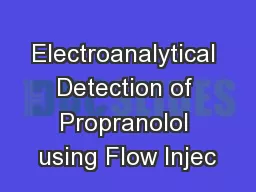

Joy Qiu Dr Greg Swain HSHSP 2014 Overview To evaluate the ability of the following electrodes to sensitively reproducibly and stably detect propranolol Glassy carbon B orondoped diamond thin film ID: 594653
Download Presentation The PPT/PDF document "Electroanalytical Detection of Propranol..." is the property of its rightful owner. Permission is granted to download and print the materials on this web site for personal, non-commercial use only, and to display it on your personal computer provided you do not modify the materials and that you retain all copyright notices contained in the materials. By downloading content from our website, you accept the terms of this agreement.
Slide1
Electroanalytical Detection of Propranolol using Flow Injection Analysis
Joy Qiu
♦
Dr. Greg Swain
♦
HSHSP 2014 Slide2
Overview
To evaluate the ability of the following electrodes to sensitively, reproducibly and stably detect
propranolol
:
Glassy carbon
B
oron-doped diamond thin film
N
itrogen-incorporated tetrahedral amorphous carbon (ta-C:N) thin film
Using
flow injection analysis
with amperometric detection (FIA-EC)Slide3
Flow Injection Analysis (FIA)
Sample (
analyte
) is injected into a continuous flowing stream of carrier solution (electrolyte)
Analyte
passes over the surface of the working electrode, resulting in an oxidation reaction Movement of charge (electrons) generates a detectable currentCurrent concentration
R
O + 2H
+
+ 2e¯Slide4
Application
Why use flow injection analysis?
Better methods: HPLC, polarography, etc.
FIA: cheap, simple, fast, versatile
Enables quick detection of multiple
analytes with good sensitivityPharmaceutical applicationsDrug quality or purity
Non-invasive detection of pharmaceutical compounds in human body/urineSlide5
FIA System Set Up
Cell volume = 10-20
μ
L
Injection volume = 25-50
μ
LSlide6
Propranolol
Adrenergic non-selective beta-antagonist
Used to treat hypertension, anxiety, and panic
Effective plasma levels: 10-100 mg/
mL
Excreted as metabolites in urineOxidation of propranolol
C16H21NO2MW = 295.80g/mol
B. C. Lourencao
et al
., Electrochim. Acta. 2014, acceptedSlide7
Glassy Carbon (GC)
Extensive body of research
Structure and characteristics
Combines glassy and ceramic properties of non-graphitizing carbon with graphite
sp
2 hybridization structureGraphitic nanoribbons
Anisotropic microstructurally PolishingSlide8
Boron-Doped Diamond (BDD)
sp
3
hybridized carbon bonding
High stability and chemical inertness
B2H
6 incorporated (boron doping) into diamond films Doping increase electrical conductivityGrown on silicon substrates
Thin-film does not require polishing
~1 cmSlide9
Nitrogen-Incorporated Tetrahedral Amorphous Carbon (TaC:N)
s
p
2
and sp
3 bonded carbonNitrogen impurities added during growthShares many properties with diamond
More cost effective and versatileDiamonds: 600-800°CTaC: 25-100°C
~1 cmSlide10
Figures of Merit
What are optimum conditions for detection?
Hydrodynamic Voltammetry
How reproducible is the method?
Short-Term ReproducibilityHow well can the method detect propranolol?
Calibration Curve DeterminationSlide11
Hydrodynamic Voltammetry
(a) Glassy Carbon
(b) Diamond
(c)
TaC
Large increase in the current arises from the oxidation of water that occurs at a higher rate at the more positive potentials.
PROP oxidation
500
μ
M PROP injected; 0.1 M PBS, pH = 7.2 used as carrier solution Slide12
Short Term Reproducibility
Glassy Carbon
E
det
= 1.25 V
RSD: 6.047%
(b) Diamond
E
det
= 1.35 V RSD: 5.040%(c) ta-C:N
Edet = 1.325 V
RSD: 3.245%5 μ
M PROP injected; 0.1 M PBS, pH = 7.2 used as carrier solution Slide13
Calibration Curve
Slopes for diamond and
ta
-C:N curves greater than that for glassy carbon. This shows greater sensitivity!Slide14
Summary of Detection Figures of Merit
Figure
of Merit
Glassy
Carbon
Diamond
ta
-C:NDetection Potential (mV)
12501350
1325Sensitivity (nA/μ
M)73.4
± 3.0
154.6 ± 6.7
172.7
± 8.2
Limit of Quantification (nM)371.8 ± 87.8
76.5
± 19.5
111.6
±
12.2
Upper Limit of Linearity (
μ
M)
50
100
100
Detection Limit (
nM
)
111.5
±
26.3
22.9
±
5.8
33.5
±
3.7
R
2
Value
0.9986
0.9986
0.9983
Reproducibility
(%RSD for 25
injections of 5
μ
M PROP)
5.925%
4.866%
3.245%Slide15
Conclusions
Diamond and
TaC
v. Glassy Carbon
Lower detection limit and wider linear dynamic range
More reproducible (less fouling/surface absorption)More sensitive (ability to distinguish between signal and noise)Diamond v. TaC
Similar detection potentials Diamond: lower detection limit and wider linear dynamic rangeTaC: more reproducible and sensitive Slide16
Conclusions (cont.)
FIA-EC: viable method for detection of propranolol
Electrodes
Diamond and
ta
-C:N outperform glassy carbon Diamond and ta-C:N perform similarlyta-C:N is preferred for cost effectiveness and versatilitySlide17
Future Directions
Further optimize the method for detection
Test other pharmaceutical/biological compounds
Hydrochlorothiazide
Norepinephrine
Replicate commercial conditions - collect and test real urine samplesSlide18
Acknowledgements
Dr. Swain
D’Nisha
Hamblin
Romana
JarosovaDr. RichmondHSHSP’14